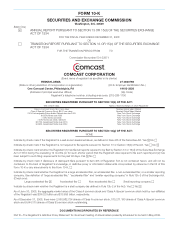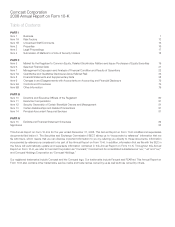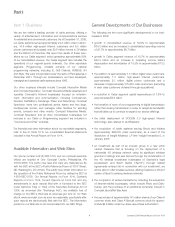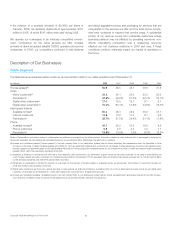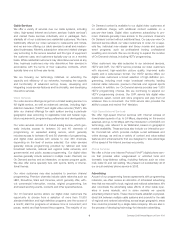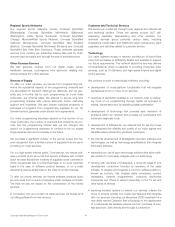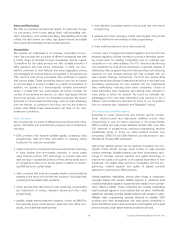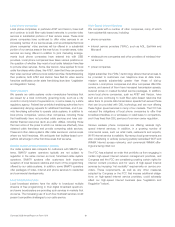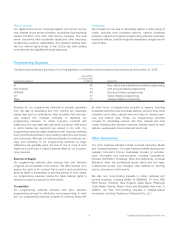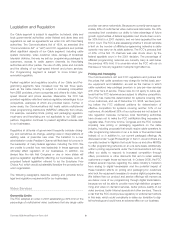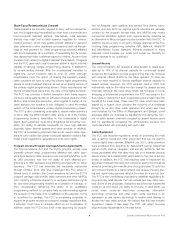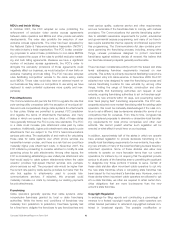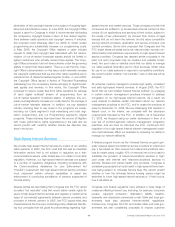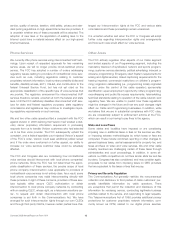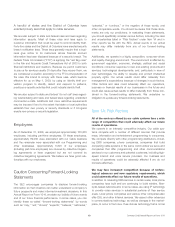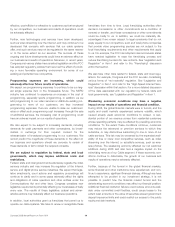Comcast 2008 Annual Report Download - page 6
Download and view the complete annual report
Please find page 6 of the 2008 Comcast annual report below. You can navigate through the pages in the report by either clicking on the pages listed below, or by using the keyword search tool below to find specific information within the annual report.Regional Sports Networks
Our regional sports networks include Comcast SportsNet
(Philadelphia), Comcast SportsNet Mid-Atlantic (Baltimore/
Washington), Cable Sports Southeast, Comcast SportsNet
Chicago, MountainWest Sports Network, Comcast SportsNet
California (Sacramento), Comcast SportsNet New England
(Boston), Comcast SportsNet Northwest (Portland) and Comcast
SportsNet Bay Area (San Francisco). These networks generate
revenue from monthly per subscriber license fees paid by multi-
channel video providers and through the sale of advertising time.
Other Revenue Sources
We also generate revenue from our digital media center,
installation services, commissions from electronic retailing net-
works and fees from other services.
Sources of Supply
To offer our video services, we license from programming net-
works the substantial majority of the programming channels and
the associated On Demand offerings we distribute, and we gen-
erally pay a monthly fee for such programming on a per video
subscriber, per channel basis. We attempt to secure long-term
programming licenses with volume discounts and/or marketing
support and incentives. We also license individual programs or
packages of programs from programming suppliers for our On
Demand service, generally under shorter-term agreements.
Our video programming expenses depend on the number of our
video customers, the number of channels and programs we pro-
vide, and the programming license fees we are charged. We
expect our programming expenses to continue to be our largest
single expense item and to increase in the future.
We purchase a significant number of the set-top boxes and net-
work equipment from a limited number of suppliers that we use in
providing our video services.
For our high-speed Internet portal, Comcast.net, we license soft-
ware products (such as e-mail and security software) and content
(such as news feeds) from a variety of suppliers under contracts in
which we generally pay on a fixed-fee basis, or on a per customer
basis in the case of software product licenses, or on a video
advertising revenue share basis in the case of content licenses.
To offer our phone services, we license software products (such
as voice mail) from a variety of suppliers under multiyear contracts.
The fees we pay are based on the consumption of the related
services.
In connection with our provision of cable services, we license all of
our billing software from two vendors.
Customer and Technical Services
We service our customers through local, regional and national call
and technical centers. These call centers provide 24/7 call-
answering capability, telemarketing and other services. Our
technical services group performs various tasks, including
installations, transmission and distribution plant maintenance, plant
upgrades, and activities related to customer service.
Technology
Our cable systems employ a network architecture of hybrid fiber
coax that we believe is sufficiently flexible and scalable to support
our future requirements. This network allows the two-way delivery
of transmissions, which is essential to providing interactive video
services, such as On Demand, and high-speed Internet and digital
phone services.
We continue to work on technology initiatives, including:
• development of cross-platform functionality that will integrate
key features of two or more of our services
• recapture of bandwidth available in our network, both by deliver-
ing more of our programming through digital, as opposed to
analog, transmission and by exploiting digital optimization
• development of technology that provides early detection of
problems within our network and provides our technicians with
enhanced diagnostic tools
• development of software for our network and for set-top boxes
that measures the reliability and quality of our video signals and
identifies video problems for particular customers
• the internal development of strategically important software and
technologies, as well as technology specifications that integrate
third-party software
• expanding our use of open technology solutions that allow multi-
ple vendors to more easily integrate with our technology
• working with members of CableLabs, a nonprofit research and
development consortium founded by members of the cable
industry, to develop and integrate a common software platform,
known as tru2way, that enables cable companies, content
developers, network programmers, consumer electronics
companies and others to extend interactivity to the TV set and
other types of devices
• exploring wireless options to extend our services outside the
home to provide mobility and create new features that integrate
with our services, including our November 2008 investment in a
new entity named Clearwire that is focusing on the deployment
of a nationwide 4G wireless network and our purchase of wire-
less spectrum, both directly and through a consortium
Comcast 2008 Annual Report on Form 10-K 4

